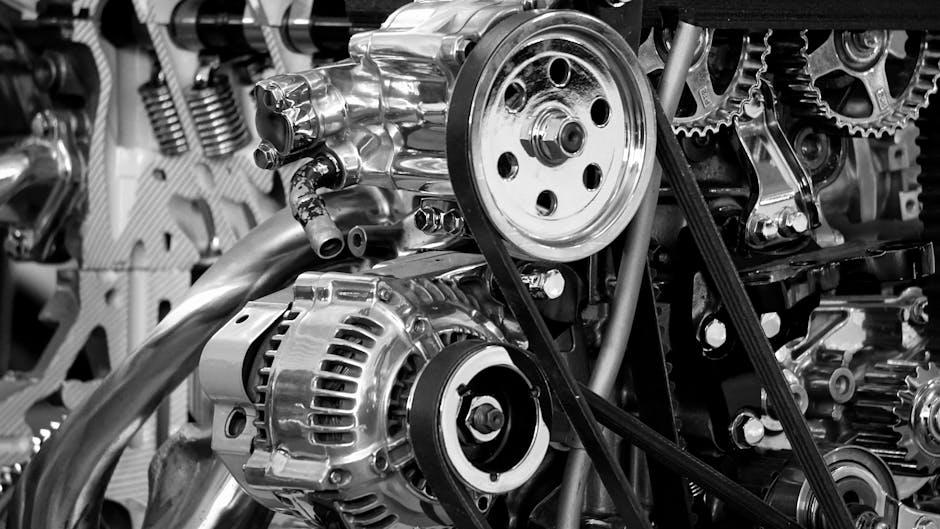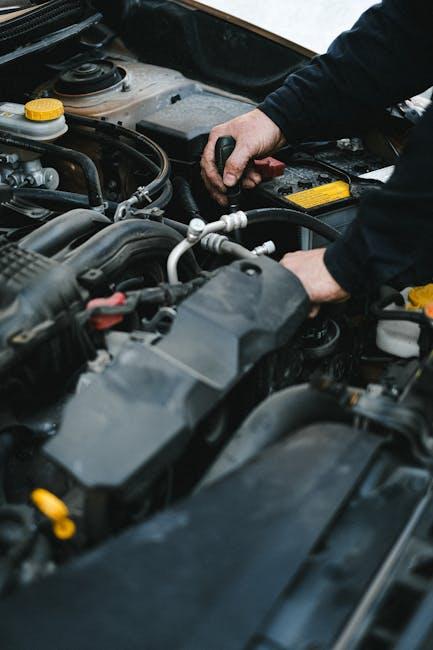In the intricate ballet of a vehicle’s mechanics, the transmission plays a starring role—seamlessly shifting gears and transferring power to the wheels. Yet, despite its vital function, the transmission often endures relentless stress, heat, and wear that can shorten its lifespan. Understanding how to extend this crucial component’s durability isn’t just a matter of saving money on repairs; it’s about preserving the heart of your driving experience. In this article, we’ll explore practical strategies and maintenance tips designed to help your transmission keep performing at its peak, mile after mile. Whether you’re a seasoned gearhead or a casual driver, mastering the art of transmission care can make all the difference on the road ahead.
Table of Contents
- Understanding Transmission Basics for Better Care
- Recognizing Early Signs of Transmission Trouble
- Choosing the Right Transmission Fluid for Longevity
- Routine Maintenance Practices That Protect Your Transmission
- Driving Habits That Minimize Transmission Wear
- When to Seek Professional Transmission Inspection and Service
- Q&A
- In Retrospect

Understanding Transmission Basics for Better Care
At its core, a vehicle’s transmission serves as the vital bridge that translates engine power into motion. Many drivers overlook basic transmission care, yet understanding its fundamental operation opens doors to smarter maintenance decisions. Transmission systems rely heavily on fluid to lubricate gears, cool components, and ensure smooth gear shifts. Neglecting fluid changes or allowing contamination can accelerate wear and lead to costly repairs. By recognizing the signs of transmission stress—such as delayed shifts or unusual noises—you can act promptly to avoid long-term damage.
Implementing routine checks and simple habits plays a major role in prolonging transmission health. Essential practices include:
- Regular Fluid Inspections: Monitor fluid clarity and level to catch leaks or contamination early.
- Timely Fluid Replacement: Follow manufacturer schedules for changing transmission fluid.
- Gentle Driving Techniques: Avoid abrupt accelerations and hard braking that strain transmission components.
- Use of Trusted Fluids: Always opt for recommended transmission fluid types to ensure compatibility.
| Action | Recommended Interval | Benefit |
|---|---|---|
| Transmission Fluid Check | Every 15,000 miles | Detect leaks and fluid degradation |
| Fluid Replacement | Every 30,000 to 60,000 miles | Maintain lubrication and cooling efficiency |
| Transmission Service (Flush & Filter) | Every 50,000 miles | Remove built-up contaminants |

Recognizing Early Signs of Transmission Trouble
Detecting small issues before they escalate can save you from costly repairs and prolong the life of your vehicle’s transmission. Common early signs include unusual noises like whining or clunking when shifting gears, slight delays or slipping during acceleration, and a burning smell that indicates overheating. Pay close attention to changes in how your car responds, especially if shifts become rough or hesitant. These subtle clues often precede serious transmission problems and should never be ignored.
Maintaining vigilance is key, but knowing exactly what to look for can make all the difference. Below is a quick guide to help you spot potential trouble spots early:
- Fluid leaks: Reddish fluid pooling under the vehicle signals potential seal or gasket failures.
- Dashboard warnings: Transmission or check engine lights can indicate electronic sensor issues.
- Shifting irregularities: Hesitation, jerking, or gear slipping are signs of wear or low fluid.
| Symptom | Possible Cause | Immediate Action |
|---|---|---|
| Grinding Noise | Worn Clutch or Gears | Check Fluid Level and Quality |
| Delayed Engagement | Low Transmission Fluid | Top Up or Replace Fluid |
| Overheating Smell | Fluid Breakdown | Service Transmission System |

Choosing the Right Transmission Fluid for Longevity
Selecting the appropriate transmission fluid isn’t just a routine maintenance step—it’s a critical decision that can make a lasting difference in your vehicle’s performance and durability. Transmission fluids come in various formulations such as synthetic, conventional, and high-mileage blends, each designed to cater to specific transmission types and driving conditions. Ignoring the manufacturer’s specifications or opting for a generic fluid can lead to inadequate lubrication, overheating, and accelerated wear of transmission components.
To ensure you pick the right fluid, consider the following essential factors:
- Vehicle Make and Model: Always consult your owner’s manual for the recommended type and specifications.
- Transmission Type: Automatic, manual, or CVT transmissions require different fluid characteristics.
- Driving Conditions: Heavy towing, mountainous terrain, or stop-and-go traffic may necessitate fluids with enhanced thermal stability.
| Fluid Type | Key Benefits | Best For |
|---|---|---|
| Synthetic | Superior heat resistance, longer lasting | High-performance, heavy use |
| Conventional | Cost-effective, meets basic needs | Older vehicles, light driving |
| High-Mileage | Seal conditioners, reduces leaks | Vehicles >75,000 miles |

Routine Maintenance Practices That Protect Your Transmission
Consistent attention to your transmission is crucial for maintaining optimal performance over the years. One of the most effective habits is scheduling regular fluid checks and replacements. Transmission fluid lubricates internal components, dissipates heat, and prevents corrosion. Over time, this fluid degrades and becomes contaminated, which can lead to erratic shifting and costly repairs. Pair fluid maintenance with a periodic inspection of seals and gaskets to catch leaks early and avoid fluid depletion. Additionally, integrating a habit of warming up your vehicle gently in cold climates helps the transmission fluid circulate and provides smoother operation.
Incorporating thoughtful driving practices goes hand in hand with mechanical maintenance. Avoiding abrupt gear shifts, harsh acceleration, and heavy towing without the proper equipment reduces stress on transmission parts. Here’s a concise checklist to adopt as part of your maintenance routine:
- Check transmission fluid level monthly
- Flush fluid every 30,000 to 60,000 miles
- Inspect transmission mounts annually
- Listen for unusual noises when shifting
- Use the correct transmission fluid as per manufacturer’s guideline
| Maintenance Task | Recommended Interval |
|---|---|
| Transmission Fluid Check | Monthly |
| Fluid Replacement | Every 30,000–60,000 miles |
| Seal Inspection | Annually |
| Transmission Mounts Check | Annually |

Driving Habits That Minimize Transmission Wear
Adopting mindful driving techniques significantly reduces the stress placed on your transmission components. Avoiding abrupt starts and stops is crucial—gradual acceleration and deceleration allow the transmission to shift gears smoothly, extending its operational life. Additionally, shifting gears at lower RPMs, whenever possible, minimizes wear and tear on the internal clutch plates and gears, further preventing premature failure.
Engaging in regular driving habits that support transmission health includes:
- Using the brake to come to a complete stop before moving the gear selector from drive to reverse or park
- Keeping your foot off the clutch pedal while idling to avoid unnecessary strain on a manual transmission
- Gradually easing into acceleration to reduce thermal and mechanical stress
| Driving Behavior | Impact on Transmission |
|---|---|
| Rapid Gear Shifts | Accelerates clutch wear and overheating |
| Idling in Gear | Increases fluid temperature, reducing efficiency |
| Proper Warm-Up | Ensures optimal fluid circulation and pressure |

When to Seek Professional Transmission Inspection and Service
Ignoring subtle changes in your vehicle’s performance can accelerate transmission wear, leading to costly repairs down the line. It’s essential to enlist expert eyes whenever you notice signs like unusual noises, delayed gear engagement, or slipping gears. These symptoms often indicate that internal components are struggling and need immediate attention to prevent irreversible damage. Additionally, if you’ve recently driven through severe weather conditions or challenging terrains, a professional evaluation can help ensure no hidden stress has compromised your transmission’s integrity.
Regular inspections become even more critical as your vehicle ages or accumulates high mileage. Maintenance schedules often recommend service intervals, but individualized conditions might demand more frequent check-ups. Consider these key triggers for scheduled or emergency transmission service:
- Unexplained fluid leaks under the vehicle
- Burning smell near the transmission area
- Warning lights or error codes related to powertrain
- Sharp drops in fuel efficiency
- Rough or jerky shifting patterns
| Symptom | Potential Cause | Suggested Action |
|---|---|---|
| Delayed Gear Engagement | Low Transmission Fluid | Check & Refill Fluid |
| Grinding Noise | Worn Gears or Clutch | Professional Inspection |
| Transmission Slips | Damaged Bands or Solenoids | Immediate Service |
Q&A
Q&A: How to Extend Transmission Lifespan
Q1: Why is extending the transmission lifespan important?
A1: The transmission is the heart of your vehicle’s drivetrain, responsible for smoothly transferring power from the engine to the wheels. Extending its lifespan means fewer breakdowns, lower repair costs, and a longer, more reliable driving experience.
Q2: What are the key habits that help extend transmission life?
A2: Regular maintenance is king. Changing transmission fluid at recommended intervals, avoiding aggressive driving habits like sudden acceleration or harsh shifting, and ensuring your cooling system works properly can all significantly boost your transmission’s longevity.
Q3: How frequently should transmission fluid be changed?
A3: While it varies by vehicle, most manufacturers recommend changing transmission fluid every 30,000 to 60,000 miles. Always check your owner’s manual—you can think of it like fresh oil for the internal gears and components, keeping everything lubricated and cool.
Q4: Does driving style affect transmission health?
A4: Absolutely! Gentle acceleration, avoiding excessive loads such as towing heavy trailers unnecessarily, and letting your vehicle warm up before driving especially in cold weather, all reduce stress on your transmission.
Q5: Can I check my transmission fluid myself?
A5: Yes, but carefully. Most vehicles have a transmission fluid dipstick—check it with the engine warm and idling, and look for clear, reddish fluid without a burnt smell. If you notice anything unusual, it’s a good idea to visit a mechanic.
Q6: What signs indicate transmission trouble?
A6: Warning signs include slipping gears, delayed shifting, strange noises like whining or clunking, or leaks under your vehicle. Catching these early can save you from expensive repairs.
Q7: Is it helpful to get a professional transmission service even if there are no problems?
A7: Preventive care is invaluable. Professional inspections can spot minor issues before they escalate, and services like transmission flushes can clear out deposits that degrade performance over time.
Q8: Can external factors like towing or terrain shorten transmission life?
A8: Yes, heavy towing, stop-and-go traffic, mountainous terrain, and frequent short trips put more strain on the transmission. Using appropriate driving techniques and ensuring extra cooling or fluid change intervals can help mitigate this.
Q9: Are aftermarket additives effective for transmission health?
A9: Additives often promise improved lubrication or cleaning, but their effectiveness varies. It’s best to consult your mechanic and rely primarily on manufacturer-recommended fluids and maintenance routines.
Q10: What’s the bottom line for extending transmission lifespan?
A10: Treat your transmission with care through regular maintenance, mindful driving, timely fluid changes, and professional check-ups. Like a well-tuned orchestra, every component plays a part in keeping your vehicle moving smoothly for miles to come.
In Retrospect
In the intricate dance of metal and mechanics that power your vehicle, the transmission plays a starring role—silent but indispensable. Extending its lifespan isn’t just about routine maintenance; it’s about forging a harmony between care, awareness, and timely action. By embracing these thoughtful practices, you not only safeguard your transmission’s health but also ensure smoother journeys and fewer unexpected stops along the road. After all, a well-tended transmission is the heartbeat of your drive, quietly steering you toward many miles of reliable adventure.


2 Comments
14bwht
14bwht